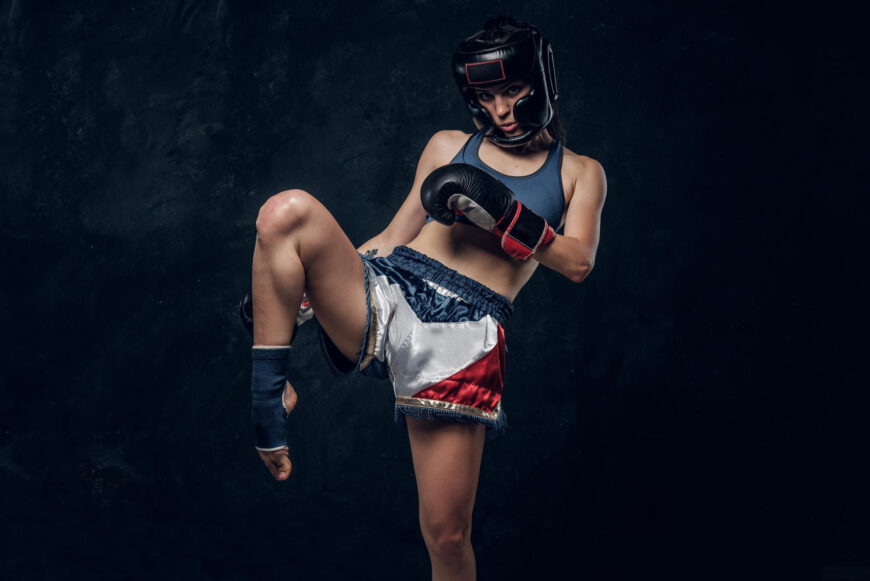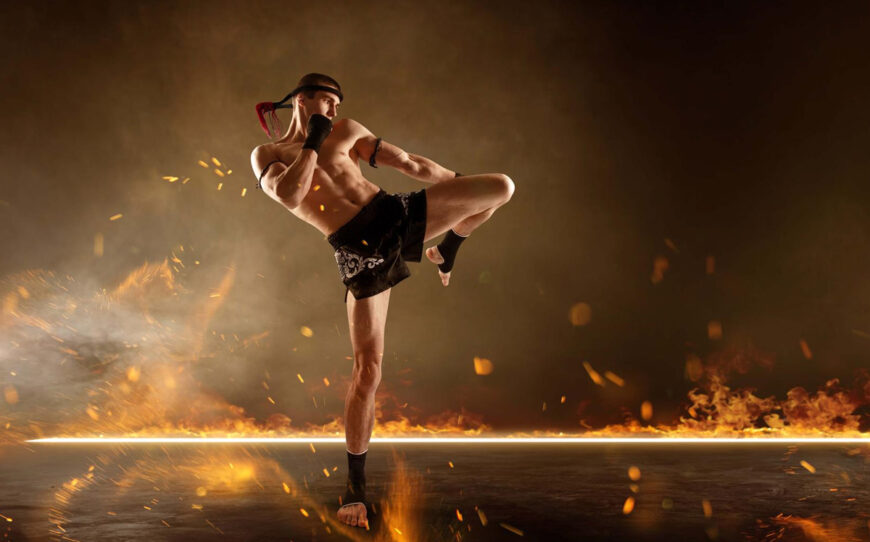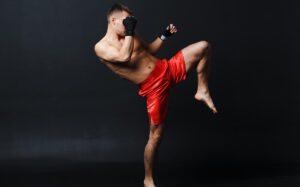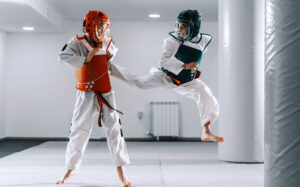Muay Thai is an ancient martial art that has been part of Southeast Asian culture for centuries. This fast-moving combat sport is often referred to as “the Art of Eight Limbs” due to its use of fists, elbows, knees and legs in a defensive or offensive manner.
It requires tremendous skill and power from the practitioner, especially when it comes to kicking. Hone your Muay Thai techniques with these basic kicks – Push Kick (Teep), Roundhouse Kick (Te Tat), Downward Roundhouse Kick (Te Kot), Diagonal Kick (Te Chiang), Jumping Kick (Kradot Te) Reverse Roundhouse Kick (Te Klap Lang), Side kick (Tad) and Axe kick( Te Khao).
Different Types of Muay Thai Kicks You Need To Know
Learn about the types of Muay Thai kicks and how to execute each one with proper technique, power, and accuracy.
Push Kick – Teep
The push kick, also known as the teep, is an essential technique in Muay Thai and a powerful weapon to keep opponents at a distance. It is used both offensively and defensively to attack the opponent’s legs or body, upset their tempo and rhythm, and create space between fighters.
To execute this kick properly, the key ingredients are proper stance, balance, chambering of the kick (cocking your knee back), and pivoting of the hips towards target while pushing off with your rear leg.
To use it effectively in combat sports such as Muay Thai requires proper training on body mechanics like flexibility and coordination which determines how agile you can move around during fights.
Roundhouse Kick – Te Tat
The Roundhouse Kick – Te Tat is a powerful Muay Thai kick often used to surprise opponents in combat. Properly executed, the power of this technique lies in its torque generated by the hips and transferring through the leg to create devastating impact.
It’s important that fighters maintain proper stance and balance during execution as it not only produces maximum force but helps maximize accuracy when aiming at an opponent’s head or body.
Knee and hip chambering combined with correct pivoting helps generate sufficient momentum for greater power output and a higher striking distance from the opponent thus reducing their chance to stop, dodge or counter attack an incoming te tat strike.
In order to effectively perform Combination kicks , martial artists need to focus on developing flexibility, muscle coordination, stamina and most especially strength training of their legs which are all imperative in executing a te tat kick worth evading by any adversary .Regular practice drills like shadow boxing , bag work along with sparring sessions also goes hand in hand towards improving precision, speed , agility and fearlessness found essential when throwing this type of kick successfully against real life physical confrontations.
Downward Roundhouse Kick – Te Kot
The Te Kot kick is an important technique in Muay Thai that is used to attack the opponent’s thigh or shoulder. This downward roundhouse kick uses the shin instead of the foot and requires a combination of power, speed, and accuracy to execute properly.
For athletes attempting this move, having proper stance and balance is key for launching into the kick with enough speed and force. To generate sufficient force, hip snapping combined with a lead foot twist on tiptoe can increase velocity while helping to target specific muscles on your opponent’s upper body effectively.
During any attempt at Te Kot it is also essential to avoid common mistakes like striking off-balance or neglecting finishing moves after chambering the punch correctly – both resulting in critical but easily avoidable errors when training for Muay Thai.
Diagonal Kick – Te Chiang
One of the foundational techniques used in Muay Thai, known as “the art of eight limbs” due to the legs and arms all being used for fighting. Te Chiang is a powerful kick akin to kicking upwards in the shape of a triangle.
To execute the Diagonal Kick – Te Chiang correctly, stand balanced on both feet with your toes facing towards your opponent and well-positioned shoulders. When you initiate the kick, pivot off the non-kicking foot while pushing down with that knee towards your belly button before redirecting energy into raising your knee just above waist level, with that leg clenched like chopping wood; use abdominals at this point too.
Your heel must be pointing downwards when connecting in order for you to achieve maximum power projection from lower parts of body (hip extensors). A proper Te Chiang should always aim at chin/head area – never anywhere else on body make sure back leg remains tense throughout entire sequence – acting almost as anchor whilst using momentum created from hip rotation so that same rear foot lands softly again after delivery.
Jumping Kick – Kradot Te
A powerful and effective technique in Muay Thai and is used to surprise opponents. It involves jumping forward into the opponent with a powerful foot thrust, off-balancing them for further strikes or follow-up techniques.
This kick requires correct posture and balance so that proper execution can take place; it’s important to maintain an open stance, keeping your center of gravity low while turning your hips in order to maintain the power behind the blow.
Properly performing this move requires practice by using shadow boxing combined with bag drills to strengthen leg muscles and sharpen reflexes. A successful Kradot Te should land at midlevel on an opponent’s body as it can be too difficult to target their head due to its quick speed.
Reverse Roundhouse Kick – Te Klap Lang
One of the most powerful and riskiest kicks in Muay Thai. It is a rarely used technique because it requires turning your back to your opponent, leaving your front side vulnerable during its execution.
This kick starts by chambering the rear leg up and then leaning sideways as you pivot on both feet with arms stretched out towards your target. The power for this kick comes from building centrifugal force which is generated by rotating the hips while transferring body weight via pushing forward off the stance foot at impact.
The target areas for Reverse Roundhouse Kick – Te Klap Lang include face, neck, shoulder, chest and arm muscles though it can vary according to individual fighter’s height differences or reach advantage against an opponent.
It also provides an opportunity to set-up combinations such as a straight punch or elbow strike after execution of this move as opponents will often duck down after being hit with a hard roundhouse kick.
Side Kick – Te Tad
The side kick, also known as Te Tad and seen in other striking arts such as Tae Kwon Do and Karate, is one of the 10 essential Muay Thai kicks fighters must master. This powerful technique can be used both offensively to score points or defensively to keep your opponent at a safe distance.
When executing the side kick correctly, you should begin by shifting your bodyweight onto your rear leg while keeping both feet firmly planted on the ground for maximum power.
Your chambering hand should hold close to your hip pointing toward the target while simultaneously pivoting from heel-to-toe with short steps until your front foot aligns parallel with the torso towards the target.
Mounting up extra power when performing this kick isn’t necessarily about using leg strength alone; it involves balance control and torque generated throughout entire kinetic chain from hips downwards towards toes which explains why strong core muscles are so important in Muay Thai practices.
As an offensive weapon, this horizontally angled technique is used primarily used for midsection strikes but due to its flexibility can be adjusted either upwards (for shoulder/deeper head attacks) or downward (hitting low opponents).
Axe Kick – Te Khao
The Axe Kick, or Te Khao in its native Thai language, is a powerful move used in Muay Thai combat sport. It involves executing a swift kick to the opponent’s head while sweeping down with your foot like an axe.
To perform this technique at full power and agility, practitioners need strong leg muscles and precision timing for perfect execution.
To master the Axe Kick requires practice; there are several boxes drills underlying groundwork techniques which allow fighters to gain more confidence and understand how body weight works during movement transitions essential for effective striking of opponents’ heads.
Proper Technique And Execution Of Basic Kicks
Muay Thai kicks involve proper form, technique and power to be performed correctly; perfecting each requires correct stance and balance, chambering of the leg, pivoting of the hips and accurate kicking with force.
Stance And Balance
Muay Thai kicks require great amounts of precision, power, and balance to be effective. Achieving the proper stance is fundamental in executing these basic kicks, as it sets up the body for correctly directed force that can inflict maximum damage on your opponent.
Proper Muay Thai stance starts with shoulders back and down, chin tucked in for protection against strikes to the face or throat area, guard position with elbows tucked in acts as a shield against incoming attacks.
Good posture allows for more efficient movement and flexibility while also providing optimal power generation from your core muscles when delivering powerful strikes.
Having good core strength and hip rotation plays an important role in throwing powerful strikes; when striking from any distance using either hand or foot techniques engaging your hips will amplify the effectiveness of each attack significantly by adding torque into each punch or kick executed accurately – this concept applies especially to spinning kicks such as roundhouse kick (te tat).
Having muscle memory means practicing technique over time which leads to knowledge retention allowing fighters to throw spontaneous combinations at different angles depending on their opponents’ defensive are offensive approaches.
Chambering And Pivoting
Chambering and pivoting are important techniques used for proper execution of basic kicks in Muay Thai. Chambering refers to the body positioning required to generate power – where a fighter chambers their knee before they launch it into the kick.
Pivoting is essential for movement accuracy, involving a quick rotation of the hips that helps the fighter transition from defense to offense more efficiently.
When executed correctly, chambering and pivoting help fighters build up greater force when launching basic kicks while maintaining control over its accuracy. The balance obtained by these techniques allow fighters to deliver powerful blows even in tight fighting situations – especially during side kicks or jumpkicks where there’s less time and space for movements like stepping or turning around without losing focus on their targets.
Kicking With Power And Accuracy
Kicking is an essential part of Muay Thai, and strong, accurate kicks could very well be the difference between winning and losing. Power in a kick comes from utilizing hip rotation, as opposed to simply pivoting on the ball of the foot.
Even when power techniques are used incorrectly or with a lack of proper technique, there can still be potential for damaging strikes landed on opponents.
Achieving accuracy requires making sure you have good balance before initiating any type of kick which allows you to control your center-of-gravity movement throughout execution—allowing successful chambering and pivoting into target area without overextending or overbalancing yourself.
Reaction speed is also key as it helps increase accuracy by allowing fighters time to adjust their aim even when moving at great speeds mid flight.
How To Improve Your Muay Thai Kicks
To become an impressive Muay Thai practitioner, incorporating drills and exercises to increase muscle memory and practice proper technique consistently are essential.

Practice Proper Technique
Proper technique is the cornerstone of successful Muay Thai kicking. Proper form begins with proper footwork, balance and hip rotation. This involves keeping your posture low and utilizing your body’s core strength to generate power for each kick.
When you maintain a strong stance throughout a roundhouse kick or side kick, it helps ensure that your strikes reach their target quickly and accurately. To develop good technique there are a number of drills and exercises which focus on increasing ankle mobility, improving balance, strengthening the core muscles, building flexibility in the hips and focusing on visualization during practice rounds.
Achieving efficient Muay Thai kicks requires many hours of dedicated practice so it’s essential to remain mindful of correct technique at all times; any minor regulation can lead to problems when attempting more elaborate techniques like jump kicks or reversed control leg trips (KL Pa Lang).
Additionally, misconception regarding suitable training methods sometimes leads practitioners astray as attempting overly advanced training without proficient knowledge will cause muscle tightness leading to diminished performance rather than enhanced results.
Improve Flexibility And Leg Strength
Flexibility and leg strength are essential for Muay Thai fighters. Improved flexibility helps conserve energy by allowing the fighter to deliver high kicks easily, while strong legs can improve accuracy and power of all types of Muay Thai kicks. Here are some tips on how to increase your flexibility and leg strength:
- Improve flexibility with stretching routines that target the hip flexors, quads, hamstrings, calves, and glutes – all areas used in kicking movements. The lunge stretch is a great way to open up the hips for better kick technique.
- Strengthen muscles through extra leg work such as squats and lunges with added weights or resistance bands; core exercises like planks will also help stabilize you during fights. Building muscle endurance ensures you won’t tire out after delivering multiple powerful kicks quickly during a fight.
- Increase shins’ toughness with shin conditioning drills such as rolling a beer bottle back-and-forth against them or hitting your shin pads repeatedly with hard objects for protection against low level strikes coming from opponents’ feet – both techniques will reinforce those bones for optimum performance when executing any roundhouse kick (Te Tat) move on an adversary without getting injured yourself!
- Don’t forget agility/coordination exercises too – jogging intervals combined with skipping rope, box jumps onto elevated platforms…”shadowboxing” formulae where mental imagery plays role just show nonstop movement over time gives best results since they toughened the body whereas boosting reflexes along so don’t neglect those parts either if looking towards improving overall game exponentially without risking injuries due excessive fatigue – pay attention even at quick changes wind direction while using different angles attack each other!
Incorporate Shadowboxing And Bag Work
Shadowboxing and bag work are two key components of any Muay Thai training regimen. Shadowboxing enables beginners to hone their technique, build muscle memory, and create a solid foundation for further skill development.
By combining the elements of visualization, footwork, posture and basic strikes in shadowboxing drills, fighters can develop greater awareness of range and timing when striking an opponent’s offensive attacks.
Bag work is equally as important because it helps improve power and accuracy on your kicks. It also allows you to practice combinations such as lead-leg front kick followed by rear leg roundhouse without the risks that come with sparring drills.
Drills like slide steps across the heavy bags or leather thai pads help involve all parts of your legs – from hip flexors to feet muscles – into perfecting your kicking form proper chambering techniques on both sides.
To maximize these exercises don’t forget warm ups before executing any explosion movements! Conditioning moves like skipping rope are especially helpful for martial arts fans who want to enhance their agility while improving overall fitness levels too.
Add In Training Drills And Conditioning Exercises
In order to improve Muay Thai kick speed and power, it is important to add various training drills and conditioning exercises into your routine.
Specific drills are available that can help build core strength in the legs while increasing speed and explosive power when kicking.
It is also beneficial to focus on technique, especially for newbies who may be learning basic kicks such as push kicks (Teeps) or Roundhouse Kicks (Te Tat).
Adding strength or flexibility conditioning exercises should only be done after developing proper technique. Core workouts such as planks or jump squats can help increase explosiveness without sacrificing form and accuracy of the kick itself.
Bag working adding towards heavy bag sessions allows an individual to master techniques at a faster rate by instilling proper movement patterns in a dynamic setting with resistance instead of just practicing alone with no feedback from an opponent on how effective the kick actually was performed.
FAQs
1. What are the basic Muay Thai kicks?
The most common Muay Thai kicks include the roundhouse kick, push kick, axe kick and teep. Each has its own advantages in terms of power, speed and distance traveled.
2. How should I practice my Muay Thai kicking technique?
Focus on proper form with each repetition working to keep your knee bent as you lift your leg up and extend it outward/forward when executing any of these techniques during a training session or competition match. Repetition is key for improving strength & accuracy so strive to perfecting technique through repetition over time – incorporating various combinations as well as footwork drills to ensure all traditional methods are mastered prior attempting more advanced variations (ie: spinning kicks).
Conclusion
The proper technique and execution of basic Muay Thai kicks are essential to improving a practitioner’s overall performance in the ring. Incorporating different varieties of kicks into your training can help to increase power, endurance, flexibility, versatility, accuracy and range.
The fundamentals of Muay Thai provide practitioners with an effective self defense system that uses eight weapons: hands, elbows,, knees and shins. Different types of Muay Thai Kicks such as the push kick (teep), roundhouse kick (te Tat) or diagonal kick (te Chiang) can be used depending on the situation and opponent’s position Creating one’s own styles with various combinations of well executed basic techniques will give you an edge over your opponents in competition.
Read more:
- How Muay Thai & Kickboxing Can Help You Lose Weight
- Muay Thai Training: Comparing Golden Era Training to Modern American Muay Thai
- The Best Elbow Wars and KO’s in MMA and Muay Thai
- Why Saenchai is The Best Muay Thai Fighter of All Time
- Top Muay Thai Fighters to Follow on Instagram
- How to Avoid Shin Splints in Muay Thai
- The Best Muay Thai Shorts Reviewed









